
In this Mad Mimi review, we take a look at the pros and cons of one of the cheapest email marketing tools available. Should you use it for your business, or go for a better — but more expensive — solution?
Important update: the Mad Mimi product was discontinued at the end of August 2024. If you’re interested in trying out some alternative email marketing solutions that can be used at a relatively low price point, we’d suggest investigating GetResponse or AWeber (or Omnisend if you’re working in ecommerce).
When it comes to picking a tool for creating e-newsletters, there are loads to choose from. Mailchimp, Campaign Monitor, GetResponse and Aweber…the list goes on.
On first inspection, these products allow you to do the same thing — put attractive marketing messages in inboxes. But they can differ enormously in terms of both price and features, and it can be difficult to know which one to use.
In this review we take a look at one of the more affordable email marketing tools out there: Mad Mimi. Is it cheap and cheerful, or does it cut too many corners to make it a professional email marketing solution for your business?
Let’s find out…
Mad Mimi pricing
As mentioned above, Mad Mimi is very competitively priced.
There are four main plans, each with several pricing sub-tiers (fees are in USD):
Basic plan
$10 per month allows you to host and send e-newsletters to 500 email addresses
$12 per month — 1,000 email addresses
$16 per month — 2,500 email addresses
$27 per month — 5,000 email addresses
Pro plan
$42 per month allows you to host and send e-newsletters to 10,000 email addresses
$59 per month — 15,000 email addresses
$89 per month — 25,000 email addresses
$139 per month — 35,000 email addresses
Silver plan
- $199 per month allows you to host and send e-newsletters to 50,000 contacts
$279 per month — 75,000 email addresses
$369 per month — 100,000 email addresses
$549 per month — 150,000 email addresses
$749 per month — 250,000 email addresses
Gold plan
$1,049 per month – 350,000 email addresses.
$1,499 per month – 500,000 email addresses
All the plans with allow you to send an unlimited number of emails until your audience exceeds 75,000 subscribers – after this, send limits apply (see table below). If you exceed these send limits, you’ll have to pay an additional $0.40 per additional 1,000 messages sent (which, to be fair, is very reasonable).
| Audience size | Send limit |
|---|---|
| 75,000 | 750,000 |
| 100.000 | 1,000,000 |
| 150,000 | 1,500,000 |
| 250,000 | 2,500,000 |
| 350,000 | 3,500,000 |
| 500,000 | 5,000,000 |
Other than send limits, the key difference between the four Mad Mimi pricing tiers is to do with speed – the more expensive the plan, the faster Mad Mimi sends your emails out (you can avail of ‘normal’ speed, 2x speed, 3x speed and 4x speed as you go up the pricing ladder).
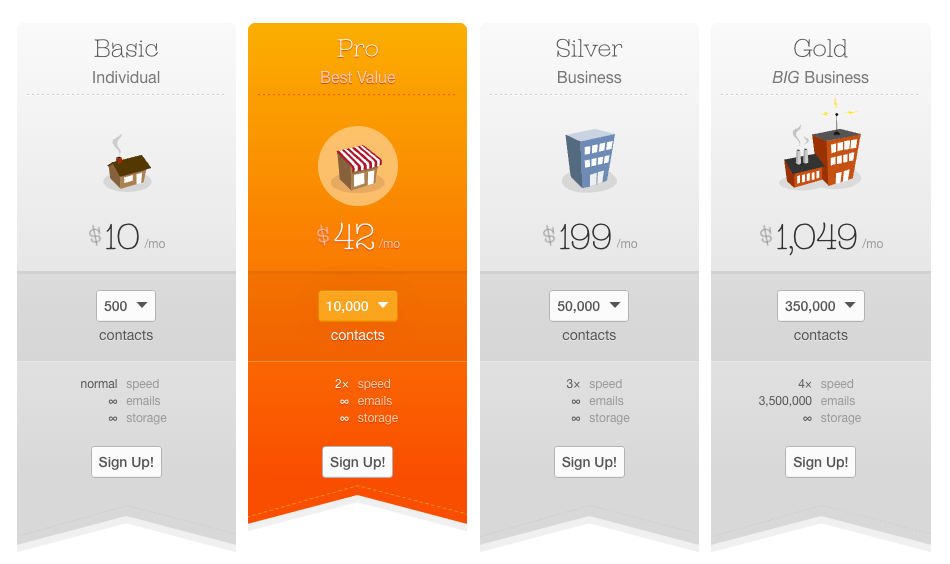
As mentioned earlier, the prices compare very favourably with those of competing products. For example, with Mad Mimi, paying $89 a month entitles you to email a database comprising 25,000 leads.
To put this in context, GetResponse charges a monthly fee of at least $149 for mailing a database this size; Mailchimp charges a minimum of $270; and Campaign Monitor’s equivalent fee is $219.
Similarly, Mad Mimi is also much cheaper than its competitors when it comes to emailing smaller databases: using a list containing 2,500 records costs $16 per month with Mad Mimi, compared to $27 via GetResponse or $45 with Mailchimp.
Unlike many competing products, however, there isn’t a free trial available for Mad Mimi.
Key competitors Mailchimp, GetResponse and AWeber all offer free trials that you can use indefinitely with lists of up to 500 subscribers.
So why is Mad Mimi so much cheaper than the competition? The simple answer is that it doesn’t come with nearly as many features.
But let’s look at what it does offer.
Interface / ease-of-use
Mad Mimi’s brightly-colored interface is very easy to use.
Thanks to large text links and big buttons, key features are easy to find, and users new to the world of email marketing will find sending e-newsletters and creating autoresponder campaigns with Mad Mimi very straightforward.
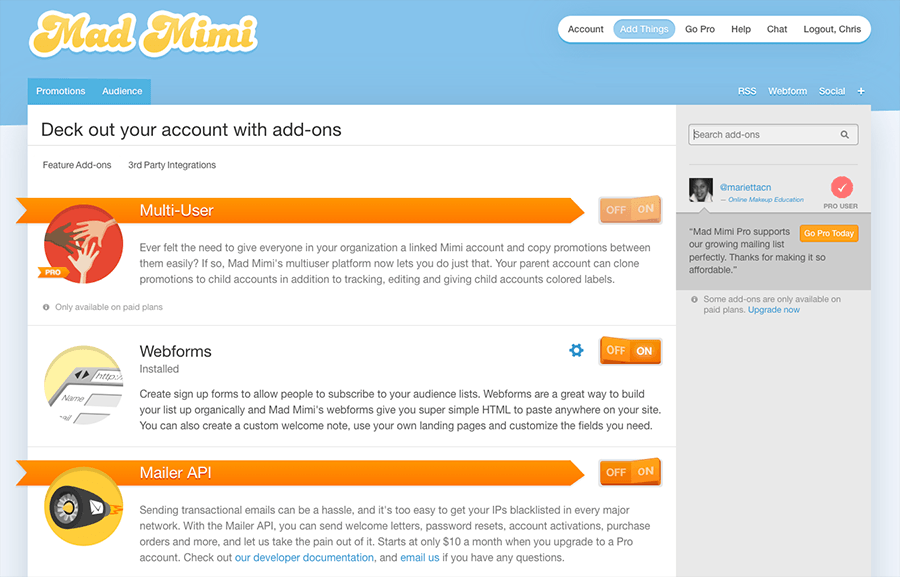
When evaluating Mad Mimi, the only thing I found difficult to do was send a test email: there’s no obvious ‘test’ button anywhere to be seen when you are designing your email.
Rather, you need to click a ‘preview’ button to see a full screen version of your email, and then locate a ‘test’ button at the bottom of that screen.

Additionally, there’s no way to preview what your email will look like on different devices — you’ll need to actually send a test email and open it on a desktop, tablet or phone to see how it appears on your chosen device.
Other than that, everything’s pretty straightforward; the learning curve is minimal.
Templates
Unlike many similar products, Mad Mimi does not provide users with an extensive range of templates to choose from. Instead, you are given one theme (albeit with a few layouts geared towards specific applications — product promotion, quick updates, newsletters etc.), and a range of color schemes to choose from.
(If you like, you can ask Mad Mimi to pull a color scheme from a website — you enter a URL and it grabs your colors for you).
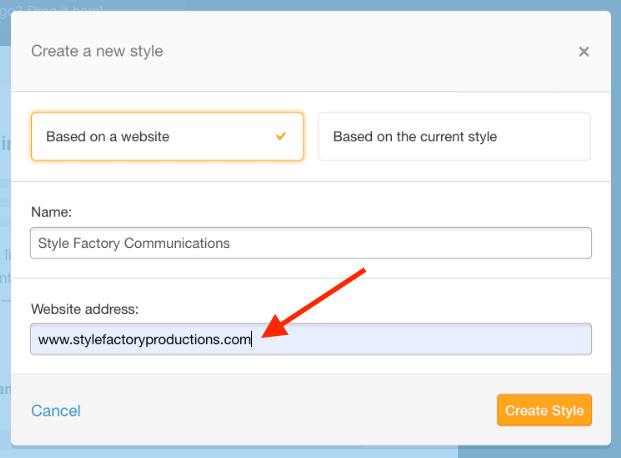
Essentially, you add your own branding to your Mad Mimi newsletter through uploading a header image, using a drag and drop builder to add your content and selecting suitable fonts to display it in (no web fonts though: only ‘safe fonts’ can be used).
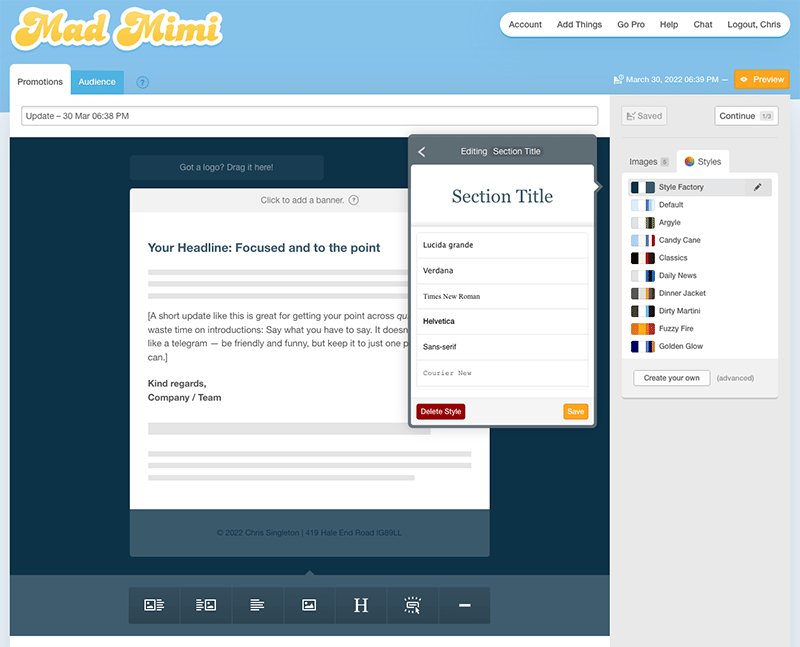
More adventurous users can use HTML to design more bespoke templates.
This approach is very basic, but it does mean that putting together e-newsletters is very simple with the platform, and you can definitely create very professional results with it.
The newsletters sent with Mad Mimi are responsive too, meaning they’ll automatically adjust their layout to suit the device they’re being accessed on (mobile, tablet etc.).
Personally, however, I’d prefer to be able to choose from a decent variety of pre-designed templates and tweak them as desired.
Autoresponders
Autoresponders are e-newsletters that are sent to your subscribers at intervals determined by you.
You can set them up so that immediately after somebody signs up to your list, they receive a welcome message from your business; a few days later they could receive a discount code for some of your products; two weeks later they could receive an encouragement to follow you on Twitter…and so on. Autoresponders tend to be a key part of email marketing platforms.
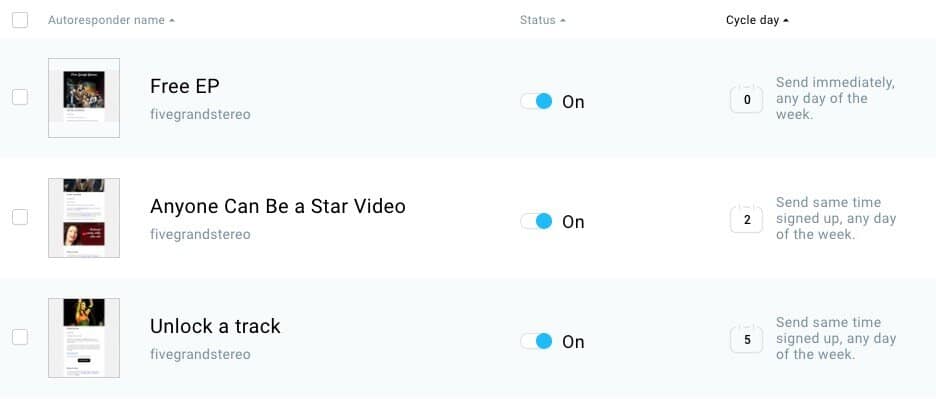
With Mad Mimi, the autoresponder functionality is easy to use: setting up ‘drip’ campaigns is very straightforward.
However, you are limited to sending emails based on time intervals and event dates (birthdays, anniversaries etc.) — and nothing more sophisticated.
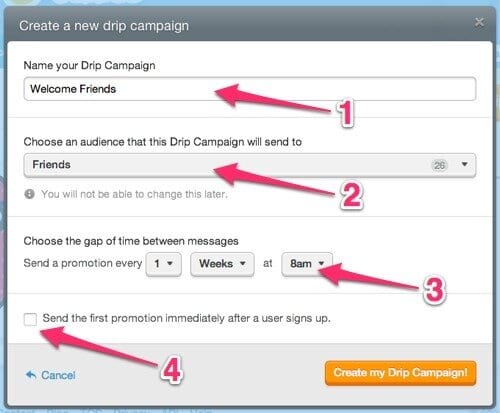
Other products, particularly GetResponse and Mailchimp, provide significantly more functionality in this area and allow you to send autoresponders that can be triggered by specific user actions or information, for example:
opens and clicks
changes in contact preferences
completed transactions
completion of a particular form
visits to particular pages on your website.
This sort of functionality tends to be referred to these days as ‘marketing automation’, and it allows you to create very sophisticated subscriber journeys and sales funnels.
If you need anything like this from an email marketing tool, you will be disappointed by Mad Mimi and are best off looking at an alternative (some suggestions below).
Key alternatives to Mad Mimi with better autoresponder features
Getresponse
GetResponse is probably the most feature-packed email marketing solution that we’ve tested when it comes to autoresponders, and it’s reasonably affordable too. Its marketing automation features are extremely strong, there’s a ‘forever free’ plan and you can use it to create very sophisticated subscriber journeys. Read our GetResponse review here.
Aweber
Although not quite as feature-packed in the autoresponder department as GetResponse, AWeber nonetheless gives you a lot more automated journey building features than Mad Mimi. It’s also one of the few email marketing platforms to offer phone support on all its paid plans. Learn more about Aweber here.
Mailchimp
Mailchimp is another good option for creating autoresponders — like GetResponse it allows you to create very ‘bespoke’ subscriber journeys. However, it is more expensive and you get charged for every contact in your account — whether they’ve subscribed or not. Find out more about how Mailchimp compares to Mad Mimi here.
Campaign Monitor
Campaign Monitor has an excellent interface and superb marketing automation features — it’s probably one of the easiest tools to create autoresponders with. However, it is one of the most expensive tools of its kind. Find out more about Campaign Monitor here.
Sign-up forms
When it comes to the mechanics of capturing email addresses, Mad Mimi gives you an easy-to-use form designer. You can use this to construct a form and are then given a snippet of code that you can use to embed it on your website.
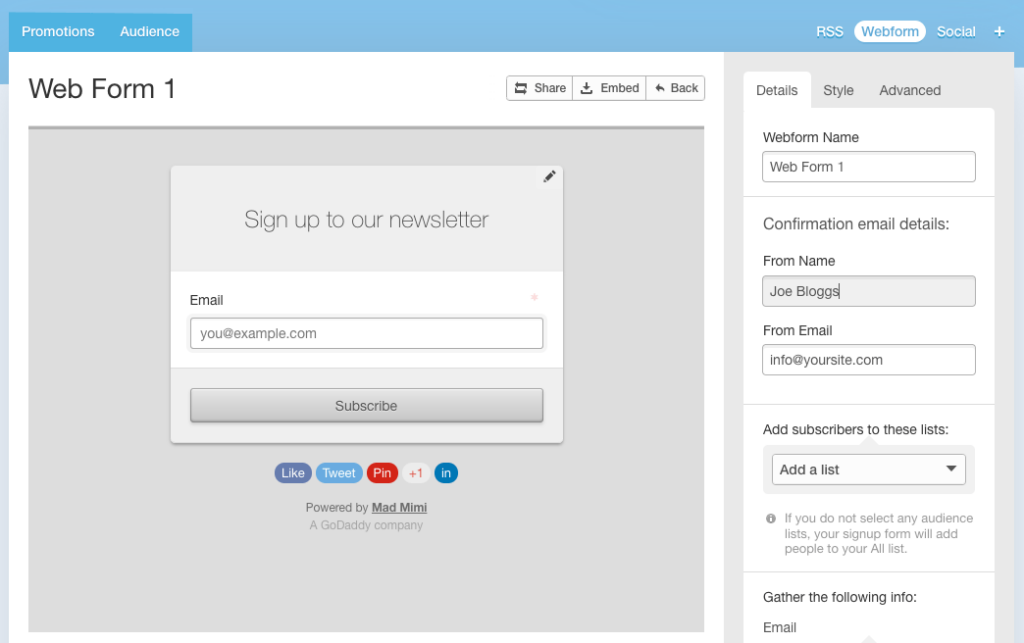
However, the form designer is pretty limited in terms of what you can do with it. Although you can adjust the color scheme of the forms you create, you have no control over the typefaces used on them, meaning that they may not tie in neatly with your brand.
(That said, you can also create ‘plain embed’ versions of your form which you — or a developer — could style with CSS.)
You are also unable to create pop-up or mobile-friendly forms with the form designer, which is another drawback (that said, workarounds exist — you can create quite sophisticated popups for Mad Mimi by using it in conjunction with form building tools like Poptin or Privy).
Analytics
Mad Mimi offers a clean, simple analytics interface that makes understanding the basics of what’s happened with a mailout easy.

You get access to all the absolutely essential stuff — open, clickthrough and unsubscribe rates etc. — and the Google Analytics integration is good too (Mad Mimi will rewrite the URLs in your emails so that any traffic from specific Mad Mimi mailouts is easily trackable in your Google Analytics reports).
However, you won’t get anything like the sort of reporting functionality that’s offered by other leading email marketing products.
For example, if you want to find out information about the devices your e-newsletters are being opened on, the ROI of emails or geographical data, you will be disappointed.
As with much else about the product, Mad Mimi provides a very stripped-down, basic approach to reporting.
Split testing
A significant omission in Mad Mimi’s feature set is the lack of split testing.
Split or A/B testing allows you to create different versions of your e-newsletters which you test against each other (using a sample of your subscribers) to find out which subject headers or content generates the most opens or clickthroughs.
You can then send a newsletter containing the ‘winning’ subject header / content to the remaining subscribers (this is usually done automatically by your email marketing tool at the end of a split test).
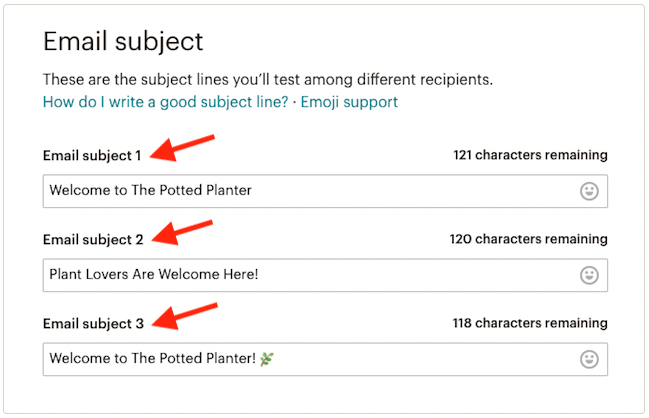
The result of split testing is usually more engagement with your newsletters — and more sales. So it’s a big shame that this functionality is not available in Mad Mimi.
(To be fair, you could split your mailing list into two ‘pots’ and run manual split tests using Mad Mimi — a ‘compare’ feature is available to help on this front — but this is a rather cumbersome way to go about A/B testing).
Data segmentation
If you’re hoping to segment your data based on fields in Mad Mimi…well, you’re out of luck here too.
Although it is possible to create multiple lists, and manually add email addresses to them, you’re not going to be able to define ‘always-on’ filters that automatically segment your data into different batches.
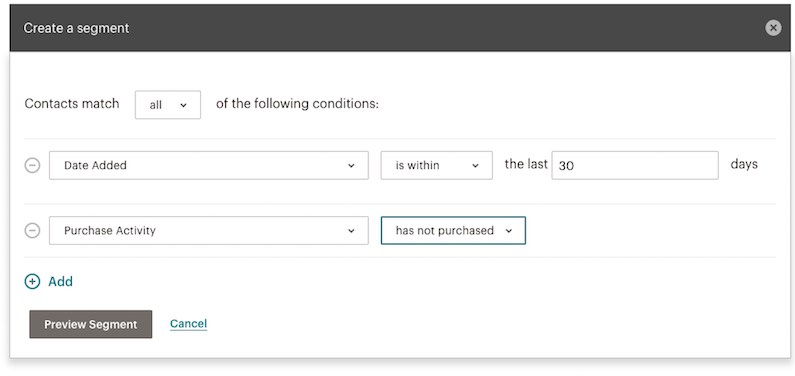
So, if you want to segment your mailing list in any way, you’d be better off avoiding Mad Mimi and looking at an alternative email marketing tool — when it comes to data segmentation, my two favourites are GetResponse or Campaign Monitor.
Don’t miss out on our free Business Growth E-Kit
For a limited time only, we’re offering our readers some excellent free tools to help them grow their business. Sign up free to immediately receive:
- downloadable cheatsheets on how to grow an online business
- an exclusive discount code for email marketing app GetResponse
- a 30-day free trial of Canva Pro
- extended free trials of essential growth-hacking apps
- ongoing free tips and advice on digital marketing
We respect your privacy, and you can unsubscribe any time. View privacy notice.
Integrations with other apps
Mad Mimi provides quite a few useful integrations to add functionality to its standard feature set — you can connect the product to a decent range of third party apps in a variety of ways. At time of writing, 53 integrations are available.
Key Mad Mimi integrations includes apps such as:
You’ll find an exhaustive list of Mad Mimi integrations here; but if there isn’t an integration available for a tool that you want to use, there’s always the option of using a third-party syncing tool.
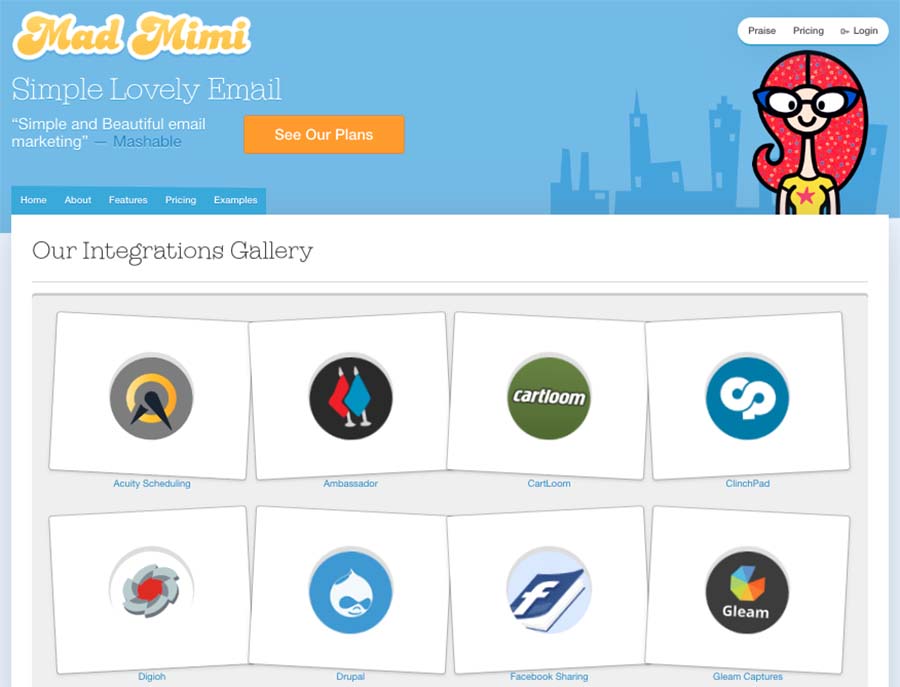
For example, although there’s no built-in Wix integration for Mad Mimi, the automation tool Zapier (pictured below) lets you connect the two tools together via a ‘zap’ — ‘if this, then that’ rules that you define.
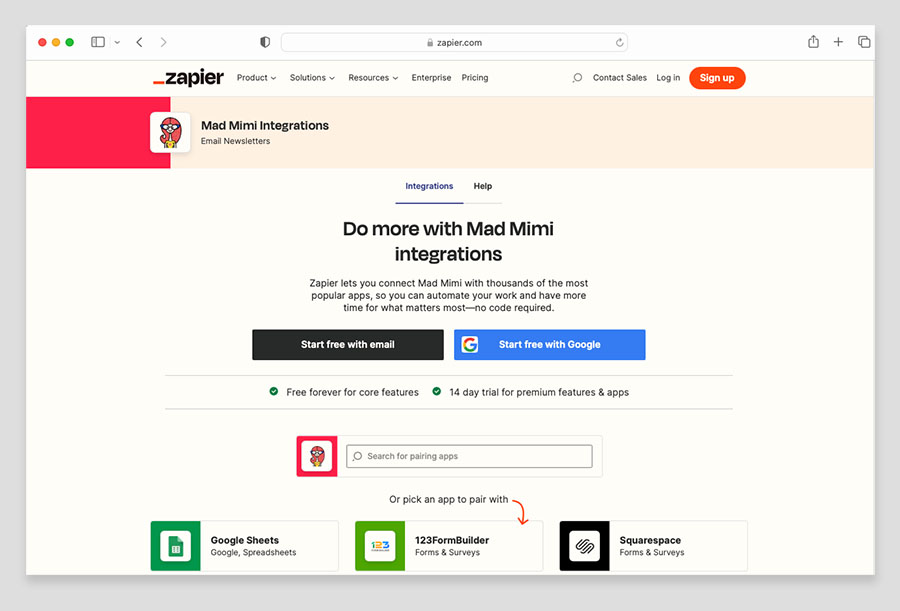
Customer support
Three types of support are available from Mad Mimi:
a set of searchable online resources
- live chat (9am to 6pm EST, Monday to Friday)
email support.
If you want phone support, this can be arranged, but you’ll have to email Mad Mimi first to request it.
In terms of how Mad Mimi’s support shapes up against that provided by its competitors, the offering is reasonably good; other companies offer more accessible phone support (notably Aweber) or multilingual support (notably GetResponse, but the provision here will be fine for most users.
Mad Mimi review: the verdict
There are two very attractive aspects of Mad Mimi. First: it’s very cheap. Second, it’s easy to use. These two factors may be enough to convince users to purchase a Mad Mimi plan, and if you’re on a budget, it’s hard to think of any mainstream email marketing tools that will allow you to send so many e-newsletters, so cheaply.
Mad Mimi has its flaws (and a lot of missing features!), but it will nonetheless tick quite a lot of email marketing boxes, particularly for the owners of very large databases. If all you ever want to do is send simple newsletters to a lot of people in one go, it’s hard to argue with Mad Mimi.
However, many users will find that there are some noticeable omissions when it come to the functionality available in Mad Mimi, particularly when it comes to autoresponders, marketing automation, reporting and split testing.
If you are serious about growing your business, my view is that you definitely need these sorts of features in your e-marketing toolkit.
Finally, a few templates wouldn’t go amiss: when you consider that competing products like AWeber, GetResponse and Mailchimp offer hundreds of them, it makes the offering from Mad Mimi look rather scrawny.
The pros of using Mad Mimi
As mentioned frequently above, the price. It’s one of the cheapest email marketing tools out there.
Because the emphasis of Mad Mimi is deliberately on ‘simplicity’, it’s very easy to use, and shouldn’t put off newcomers to email marketing.
It integrates with a good range of third party apps.
The cons of using Mad Mimi
The autoresponder functionality is very limited — you can create autoresponders (‘drips’) based on when people sign up to your mailing list, but that’s more or less it. Other tools, such as GetResponse or Mailchimp, allow you to create autoresponders based on a much larger range of variables — opens, clickthroughs, purchases and more.
There is only, in effect, one email template available.
Analytics are very basic.
You can’t really do A/B testing with Mad Mimi.
There’s no free trial.
Our overall rating: 2.5/5
Key alternatives to Mad Mimi
If you’re seriously considering Mad Mimi as an e-marketing solution, it’s likely you are on a budget. As such — and as you may have picked up on earlier in this Mad Mimi review — you might want to think about GetResponse.
Although GetResponse isn’t as cheap as Mad Mimi, it is still one of the more reasonably-priced tools of its kind available, and comes with a truckload of extra functionality that you won’t find in Mad Mimi — for example responsive emails, advanced autoresponder / marketing automation options, webinars and split testing (and it’s recently expanded its feature set to include webinars, autofunnels and a very basic CRM). Significantly, a free plan is available, which works with lists up to 500 records in size, and gives you access to many of GetResponse’s core features. You can learn more about the GetResponse free plan here.
Similiarly, Mailchimp offers a lot of email marketing functionality that you won’t find in Mad Mimi and provides a decent free plan (it lets you send 1,000 email newsletters per month to a list of 500 subscribers in size).
However, after a major overhaul of its pricing structure, the paid version of Mailchimp has become very expensive by comparison to its competitors (and the company sneakily charges you to host unsubscribed contacts too, which again makes life more expensive).
Finally, I’d also suggest taking a look at AWeber — this is a solid and reasonably priced email marketing tool; it’s not as feature-packed as GetResponse or Mailchimp, but it nonetheless provides significantly more functionality than Mad Mimi.
Over to you…
If you have any questions about our Mad Mimi review, or email marketing in general, do let us know by adding a comment below. We do our best to reply to all of them!
Mad Mimi review FAQ
What is Mad Mimi?
Mad Mimi is a low-cost email marketing tool that lets you create and send newsletters to subscribers, and automate your marketing via simple ‘drip’ campaigns.
Does Mad Mimi have a free plan?
No, Mad Mimi does not have a free plan. However, it is priced very competitively by comparison to its rivals. Key competing platforms that do offer free plans include AWeber and GetResponse.
How much does Mad Mimi cost?
Mad Mimi costs between $10 per month (to use a mailing list containing 500 records) and $1499 per month (to use a mailing list containing 500,000 records).
What are the key alternatives to Mad Mimi?
Key competing products include GetResponse, Mailchimp, AWeber and Campaign Monitor.
Related resources
If you are interested in creating e-newsletters and email marketing campaigns in general, check out our article on how to create a newsletter. Our top tips on how to grow your email list may also be of interest.
Comments (12)
Like the metrics, the ability to see what emails were delivered, how many were read, etc. Our community group is only about 80, but it took me over 2 days to send one ‘promotion’ email to our group – Mad Mimi only allowed it to be sent in batches of 10, which then had to be approved manually by their support. They are closed a lot – at night, and all weekend. So I could send 10, then WAIT and WAIT. Now I sent an email asking how to do that better and got an autoreply – closed for weekend, hear back within 48 hours. Not happy.
We use remail.io it has unlimited contacts though not free.
I am currently using Mad Mimi. Many people I know are usung Convertkit. What is your opinion about Convertkit?
I used Mad mimi for couple years but disastrously lately they always put the account on hold and many incident on regards of spam when I have been used the same previously and never have any problem as well all of them are my customers. It sounds like the software can not maintain a data such as 150,000 contacts. I am moving out to something else.
I used to love Mad Mimi but unfortunately the last few months, they’ve become extremely unreliable – far too many episodes of downtime or other glitches stopping users ending mailouts. About to switch.
I guess 2.500 contacts in free plan is a thing of the past. I see only 100 now. Time to change the article?
Hi Matt – thanks for spotting that. You’re dead right: they’ve sadly reduced the size of the mailing list that you can use in the free plan – have updated the article accordingly today. Best Chris
Hi,after reading your article i sign up to madmimi.As they allow 2000 email for free user i tried to send email to about 400 people. but they denied my promotion.is it because my account is not premium account or i put affiliate link there?can u plz tell me how can i get accepted?
thnxReply
Hi there Raihan – probably best to contact Mad Mimi direct about this if that’s okay? I think they need to approve your first mailout to ensure it’s not spammy etc. and after that you can use it as normal.
I’m undecided between Mad Mimi & Campaign Monitor… wonder if you can help me out with your thoughts? I’d ideally like to have the company brand removed from the email, so this rules out the free package with MM – otherwise, I’d have tried this out first. Many thanks.
Hi there Karen, Campaign Monitor is a better solution in many ways – it’s easier to use and the template editor is a lot better than the Mad Mimi one (plus its email designs are responsive, meaning their layout adjusts automatically so that they look good on a mobile device). However Campaign Monitor is also one of the more expensive e-newsletter tools, and it doesn’t come with a free plan. So if cost is your issue you will find that Mad Mimi really is the best option. It has an extensive feature set plus it is really cheap, and the free plan is great value.
MadMimi will remove the "Powered by MadMimi" if you’re under the paid model.